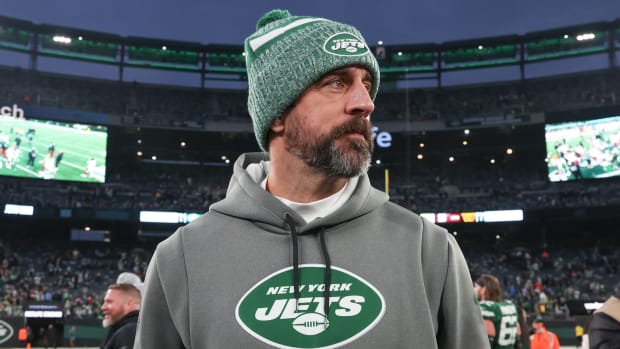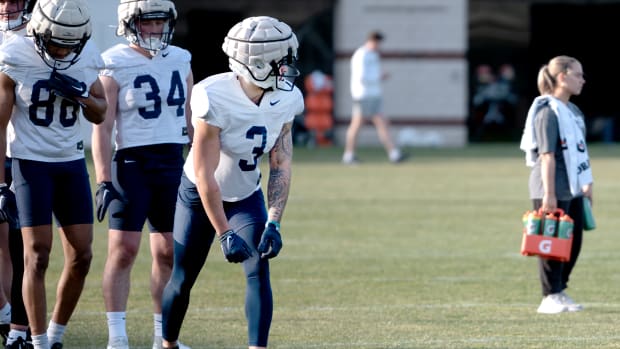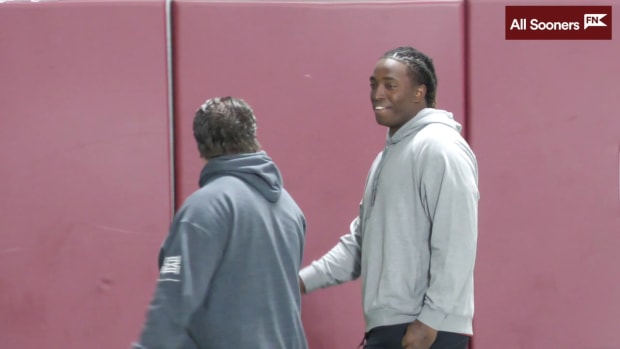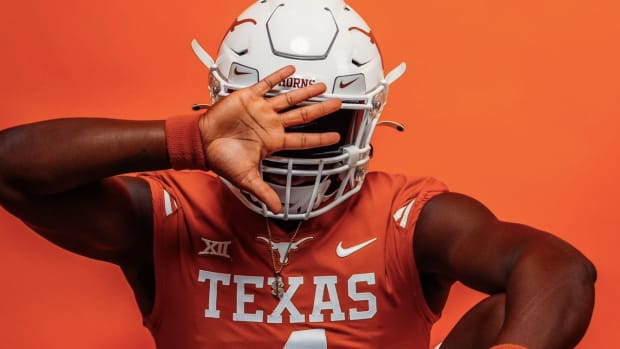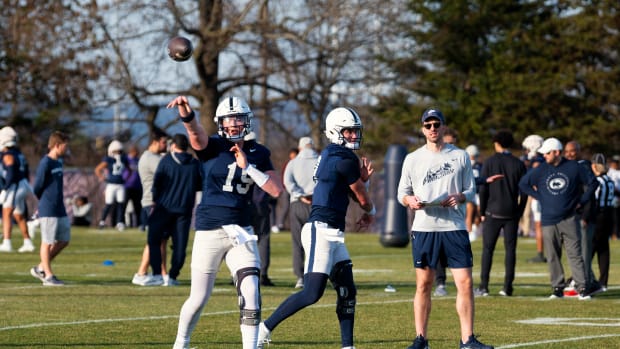No Domino Effect: How Three Men in Three Conferences Helped Keep the College Football Season Alive
John Swofford will never forget the phone call.
It was late on a Tuesday night, Aug. 11, toward the end of one of the wildest days in the modern era of college football. Both the Big Ten and Pac-12 had announced the cancellation of their fall football seasons, with potential plans to play in the spring.
Suddenly, the Power 5 had quickly whittled to the Power 3. And even that was in jeopardy. Big 12 conference leaders spent that Tuesday night hearing from medical experts before making a decision of their own: to play or not to play.
Swofford, the ACC commissioner, anxiously awaited the call about the Big 12’s decision. Finally, the name came flashing across his phone.
Bob Bowlsby.
“When Bob let me know their board [of presidents] voted to continue,” Swofford says, “well, we were pleased to hear that.”
Now, more than two months later, Swofford acknowledges a somewhat long-rumored theory: Without at least three Power 5 conferences committed to playing in the fall, no one would have played.
He’s not alone in that assumption.
“It was a wobbly triumvirate,” Big 12 commissioner Bob Bowlsby says. “Had one of the legs come off the three-legged stool, we would have fallen over.”
During that stretch of days in August, college football hung by a thread, twisting in the wind, on the very precipice of a complete shutdown. Like a row of toppling dominoes, conferences began to drop off one by one: the MAC on Aug. 8, the Mountain West on Aug. 10, the Big Ten and then the Pac-12, both on Aug. 11.
Amid the decisions, many within the industry prepared for the worst: At some point, the dominos would all topple and college football would come to a screeching halt.
But that never happened.
Three men, each in charge of one of college football’s richest conferences, helped keep alive a 2020 fall college football season. Bowlsby, Swofford and SEC commissioner Greg Sankey were the glue holding one another in tact. For nearly a month, starting after that Tuesday night, the three men spoke daily. They leaned on one another, shared information and made a pact, even if it was unofficial in nature or even unsaid.
“Had it gone below three [Power 5 conferences], I think it would have gone to zero,” says Swofford. “From the discussion that Bob and Greg and I had, my impression was that had we dropped out, the SEC and Big 12 probably would not have played. Had it gone down to us and one other conference, we likely would have not gone forward.”
Eleven weeks after that torrid stretch of days, the four conferences that postponed their fall seasons begin to play football again, each of them having reversed course in mid-September, just six weeks after their original decision. The Big Ten kicks off Friday night with Illinois against Wisconsin, and the Mountain West starts Saturday. The MAC is back on Nov. 4, and the Pac-12 kicks off Nov. 7.
By the time some schools out west begin their seasons, most SEC teams will have completed at least five games and some a half-dozen. A few ACC teams will be playing Game 8, and at least two programs, Texas State and UTSA, will kick off their ninth game.
For the most part, teams currently playing are at least one-third of the way through their seasons, having experienced the road bumps of playing football amid a pandemic. So far, college football has seen games postponed a day before kickoff and games scheduled a week from kickoff. Some of the sport’s most prominent programs have shut down for two weeks because of outbreaks, and at least 10 FBS head coaches have announced they’ve tested positive for the virus, with three of them having reported symptoms.
A total of 168 football games have been played and 34 have been postponed or canceled for COVID-related reasons—an impact of 16.8%. Some conferences have fared better than others, from Conference USA’s 13 postponed games to the SEC’s two.
All in all, the three commissioners who kept the sport moving forward believe it’s been a success. They are, of course, quick not to celebrate so soon—“I’m not ready to declare victory,” Bowlsby says—but administrators from their leagues use a stronger vocabulary.
“We are focusing so much on the negative in our country,” says Texas AD Chris Del Conte. “It’s pretty dang awesome that we are able to put protocols in place and play these games. It’s an unbelievable success.”
Several weeks removed from the postponement decisions, conference administrators from the ACC, SEC and Big 12 reveal their thoughts and feelings on, specifically, the Big Ten bailing on a fall season so quickly. While there is a level of understanding at the Pac-12 decision—because of governmental regulations out west—there is a level of bewilderment at the Big Ten’s move.
Administrators are careful not to be overly critical of a decision to halt sports amid a pandemic, which many still believe was the right move. There’s no I told you so’s. There is, however, a proverbial shake of the head.
In describing the Big Ten’s move, they use words like premature, impatient and political.
“The decision right then and there,” says Georgia athletic director Greg McGarity, “we didn’t understand that.”
But what spooked them most was a specific question. What do they know that we don’t?
In the Pac-12 and Mountain West, state health regulations were a driving force in their decision. In the Midwest, COVID-related heart impacts were behind the move. In all four conferences, there were serious concerns about the availability and reliability of testing, too.
“Where I was dumbfounded, when conferences started to drop off, is ‘What’s changed?’” asks LSU athletic director Scott Woodward.
Bowlsby was somewhat stumped too. Medical representatives from each of the Power 5 conferences met virtually every Tuesday, shared findings, discussed protocols and then reported to the commissioners.
“We were hearing the same medical reports and yet three of the leagues came to one decision and two came to another,” Bowlsby says. “It was a very stressful time.”
Each time a conference dropped off, it became a learning experience for those in the ACC, Big 12 and SEC. Athletic directors and commissioners in those conferences sought to answer questions from their league’s true decision-makers, the presidents and chancellors. Well, why did they shut down and we aren’t?
Administrators always turned to one place: the medical boards that they’d assembled. For instance, in the SEC, conference postponements like the Big Ten were informative steps, not determinative. “It was important information that helped us think,” Sankey says. “It was not viewed as ‘If conference A does this, we’ll do this.’”
Larry Templeton, a longtime SEC administrator who works part-time for the league office, describes Sankey as selling a plan to presidents. Eventually, “he got buy in,” Templeton says. “Greg has got a good head on him. He doesn’t panic. And he’s a good listener.”
Sankey’s “gift” is patience, says Mississippi State athletic director John Cohen. He waits until the most information can be gathered before making a significant decision. At various points in August, as conferences bailed on a fall season, Cohen was reminded of the situation with Apollo 13, he says now with a chuckle. “It was like ‘What parts of this ship are useful? What can we still use?’”
The uncertain fate of the spring was a primary reason Sankey kept moving forward with a fall season. He never received confirmation from his medical panel that the COVID-19 situation would be better by then. It led him to believe that the decision wasn’t a fall vs. spring season, but a fall vs. no season.
The SEC made decisions driven by data, not necessarily politics or other matters, says Michael Young, president of Texas A&M. The conference refused to make decisions “three months out” because “we couldn’t see three months out,” he says.
Sankey looks back at the recommendation from his medical panel to start the season so late, Sept. 26, as one of their wisest moves. SEC medical experts expected a spike in early to mid September with students returning to campus around the Labor Day holiday.
Lo and behold, a spike happened.
"I’m not certain we would have been in a position to start before the 26th with all 14 teams," Sankey says.
In the ACC, there was a strong determination to play a fall season, says Clemson athletic director Dan Radakovich. “There was this spirit of 'let’s do all we can to play this year,'” he says.
Why? Sankey asked himself that question in late July, then he texted the question to several people outside of the SEC to get their answers.
Why do we play college football?
The wave of responses and the outpouring convinced the 56-year-old to march forward. People see college football as a connection point, a rallying entity and a sign of hope. On top of that, daily calls and messages were pouring into league headquarters from SEC athletes.
I’ll do whatever. I’ll get tested every day. I just want to play.
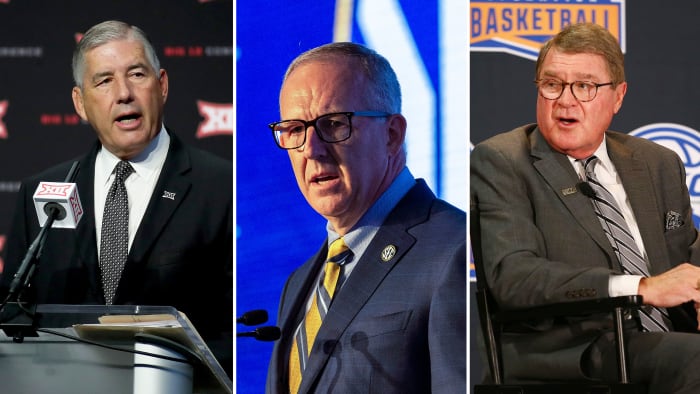
Bowlsby (left), Sankey (center) and Swofford (right) spent every day on conference calls after the Big Ten and Pac-12 canceled.
Kevin Jairaj, Vasha Hun, Jeremy Brevard-USA TODAY Sports
“One of the things people misunderstand… there’s a common refrain about money,” Cohen says, “but our kids really want to play.”
Money, however, is not inconsequential. TV contracts in the ACC, SEC and Big 12 pay schools millions each year. Living up to those contracts was a “big piece,” Radakovich acknowledges, but it wasn’t the only reason. In fact, hosting a football game without full attendance—most stadiums are at 25% capacity—is a money-loser when coupled with the monthly costs of COVID-19 protocols (testing alone can cost more than $100,000 a month).
For example, at Georgia, football ticket sales were budgeted to bring in about $63 million. With the capacity restrictions, the Bulldogs will make $12 million, McGarity says. “You’re doing it for these young people,” he says. “The TV money is keeping everyone from going further into the red.”
While the ACC and SEC seemed destined to play a fall season, their fate, in many ways, rested with the Big 12.
“They were in question. That was the first time it looked like the season was in doubt," Arkansas AD Hunter Yurachek says. "If the Big 12 would have gone in a different direction, it probably would have forced the SEC and ACC to go in a different direction."
In the Big 12, the league’s presidents and ADs were spooked by the Big Ten’s concerns over COVID-related heart issues in athletes, particularly cases of myocarditis. Hours after the Big Ten and Pac-12 postponed their seasons, Big 12 athletic directors, presidents and league medical experts held a conference call that Tuesday night with a featured guest: Michael Ackerman, a cardiovascular expert from the Mayo Clinic.
Ackerman calmed fears of league officials, says West Virginia athletic director Shane Lyons. The physician shed more light on a German-based study that showed serious heart issues with a concerning majority of COVID patients.
“The study that everybody was leaning on was not looking at a 20-year-old [patient], but was looking… the average age was 50-something,” Lyons says. “It boiled down to if the echocardiogram and MRI were not showing signs of any cautionary heart issues, there was no reason to not have a young man or woman participating.”
After Big 12 leaders agreed to move forward with a fall season, Bowlsby phoned Swofford. We’re in.
What followed was a long three weeks. The three men, Bowlsby, Swofford and Sankey, spent every day on conference calls, each knowing that if the other dropped out, it might well have caused a full-scale shutdown of college football. The Sun Belt and Conference USA were connected with the SEC and ACC, and the American felt linked to the Big 12. The College Football Playoff hung in the balance, too—likely an impossibility without the majority of Power 5 programs playing.
There were tense moments leading up to the Big Ten’s shutdown and afterward. Normally private about such feelings, Sankey reveals to SI that the week of the Big Ten’s postponement had him at least considering a cancellation of the season. Young confirms that SEC presidents discussed the prospects at length at a meeting Thursday, Aug. 6, two days before the MAC canceled and five days before the Big Ten and Pac-12 made their decisions.
At the Thursday meeting, Sankey, aware of potential decisions coming from other leagues, warned presidents about the impending postponements. “I swore them to secrecy,” Sankey says. “We were not the source of any leaks.”
“I don’t give this away much,” Sankey continues, “but I had indicated to a president… He asked what may happen and I said here’s where people are heading. As I looked at the scope, the observation I made was, ‘I don’t know what the answer is and I don’t even know how to ask the question, but are we ready to cancel the football season?’ I said that honestly.”
Over the next few weeks, a relationship formed among Sankey, Swofford and Bowlsby, even stronger than it was originally. During those daily calls from about Aug. 12 through the end of the month, they discussed mostly logistics, particularly COVID-19 protocols in their respective leagues.
When are you going to do your testing? How many are you doing? What kind? How are they administered?
SEC athletic directors were aware of an unwritten “bond” between the men, McGarity says.
“We were committed that if anything changed to immediately letting the others know,” Swofford says.
Bowlsby says the three men were mindful that at any point “it could get off the rails.” Despite rashes of outbreaks on their campuses once regular students returned, it never got too close, the three commissioners say.
Total games scheduled | 202 |
Games played | 168 |
Games postponed/canceled | 34 |
Games impacted | 16.8% |
During that time, athletic directors from one conference gossiped with those from another.
“We had heard the ACC probably was not going to play if we weren’t and so what does that do to the SEC?” Lyons asks.
It remains an unanswered question. While Sankey dances around the topic, others do not. Cohen believes the league would have played and so does Young, the A&M president. Imagine it: the SEC playing all alone, the 14 programs battling against one another for a conference championship—to hell with the Playoff.
“The SEC is a leader not a follower,” Young says. “When dominoes fall, the only one that really matters is what we’re doing. It sounds silly, but that’s the position we took.”
The SEC kicks off Week 5 this weekend. The ACC and Big 12 begin Week 7.
Sankey, Swofford and Bowlsby still talk regularly, but the Power 5 conference commissioner call is back to five, with the additions of the Big Ten’s Kevin Warren and Pac-12’s Larry Scott.
Did the… Big Three make the right decision in August?
With all other conferences now aboard to play, the decision seems justified.
A notorious bookworm, Sankey points to one of his latest reads in answering that question. He recently completed the book ‘Thinking in Bets,’ authored by former professional poker player Annie Duke. No, Sankey was not guided in his decisions by the words of a former card shark. But Duke’s book describes how the world judges leaders—and poker players, for that matter—only on outcomes.
Did you win the pot or lose your stack?
Sankey says his decision some 11 weeks ago was based on the data at that time. He bet big with pocket Jacks despite a King on the board. Risky, yes, but statistically the right move.
Says Sankey: “If I’m judged by the outcome—that is healthy competition and naming a conference champion—then you’ll have to ask me on Dec. 19.”


